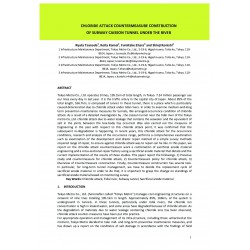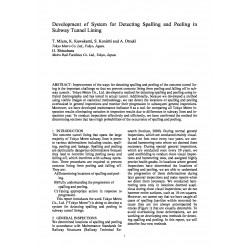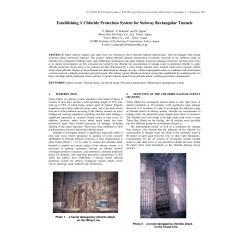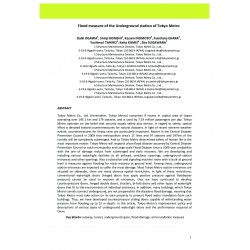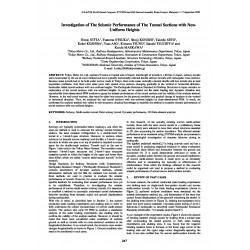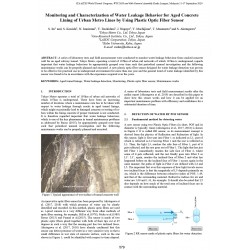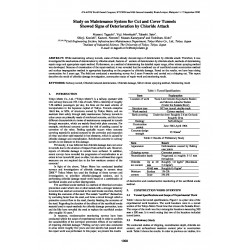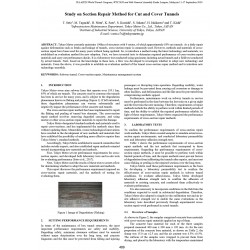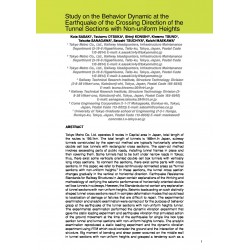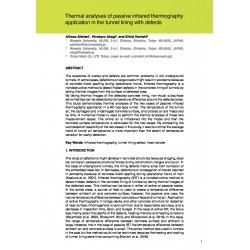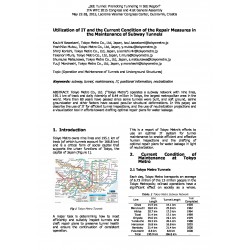No document
Search & filter
Search for a publication
Search & filter
List of products by author: S. Konishi
-
Chloride attack countermeasure construction of subway caisson tunnel under the river
Abstract: Tokyo Metro Co., Ltd. operates 9 lines, 195.1km of total length, in Tokyo. 7.24 million passenger use our lines every day in last year. It is the traffic artery in the capital city of Japan. About 85% of the total length, 166.7km, is composed of tunnel. In these tunnel, there is a place which is particularly caused deterioration due to chloride attack under tidal rivers. In order to examine...
0,00 € -
Development of System for Detecting Spalling and Peeling in Subway Tunnel Lining
Abstract: Improvement of the ways for detecting spalling and peeling of the concrete tunnel lin-ing is the important challenge so that we prevent concrete lining from peeling and falling off in subway tunnels . Tokyo Metro Co., Ltd. developed a method for detecting spalling and peeling using infrared thermography and has tested in actual tunnel. Additionally, because we developed a method using visible...
0,00 € -
Establishing A Chloride Protection System for Subway Rectangular Tunnels
Abstract: Many subway tunnels near tidal rivers are reported to have chloride induced deterioration, with the damage often found recurring where previously repaired. This project studied chloride induced deterioration of tunnels, focusing on the influence range of chloride ions contained in leakage water, and established examination and repair methods to prevent damage recurrence. Sections near rivers or...
0,00 € -
Flood measure of the Underground station of Tokyo Metro
Abstract: Tokyo Metro Co., Ltd. (hereinafter, Tokyo Metro) comprises 9 routes in capital area of Japan operating over 195.1 km and 179 stations, and is used by 7.24 million passengers per day. Tokyo Metro operates on the belief that security equals safety plus service. In regard to safety, special effort is devoted toward countermeasures for natural disasters. In light of recent extreme weather events,...
0,00 € -
Flood measure of the Underground station of Tokyo Metro
Abstract: Tokyo Metro Co., Ltd. (hereinafter, Tokyo Metro) comprises 9 routes in capital area of Japan operating over 195.1 km and 179 stations, and is used by 7.24 million passengers per day. Tokyo Metro operates on the belief that security equals safety plus service. In regard to safety, special effort is devoted toward countermeasures for natural disasters. In light of recent extreme weather events,...
0,00 € -
Investigation of the Seismic Performance of the Tunnel Sections with Non-Uniform Heights
Abstract: Tokyo Metro Co. Ltd. operates 9 routes in Capital area of Japan; total length of tunnels is 1.66 km. In Japan, subway tunnels were constructed by the cut & cover method and have typically horizontally oriented double cell box tunnels with rectangular cross sections. Because some tunnels had to be built under narrow roads in Tokyo, there exist some vertically oriented double cell box tunnels...
0,00 € -
Monitoring and Characterization of Water Leakage Behavior for Aged Concrete Lining of Urban Metro Lines by Using...
Abstract: A series of laboratory tests and field measurement were conducted to monitor water leakage behaviour from cracked concrete wall for an aged subway tunnel. Tokyo Metro, operating a total of 195km of urban rail networks of which 167km is underground, regards important that water leakage behaviour be appropriately grasped over time such that periodical manual investigation and the following...
0,00 € -
Study on Maintenance System for Cut and Cover Tunnels Showed Signs of Deterioration by Chloride Attack
Abstract: While maintaining subway tunnels, some of them already showed signs of deterioration by chloride attack. Therefore, it was investigated the mechanism of deterioration by chloride attack, features of sections of deterioration by chloride attack, methods of determining repair range and appropriate repair method. Furthermore, as a method of determining the detailed repair range, silver nitrate...
0,00 € -
Study on Section Repair Method for Cut and Cover Tunnels
Abstract: Tokyo Metro currently maintains 196km of structures with 9 routes, of which approximately 85% are tunnels. As a daily repair against deformation such as freaks and leakage of tunnels, cross-section repair is commonly used. However, methods and materials of crosssection repair have been used for many years without being updated. So, to introduce a method using the latest technology and...
0,00 € -
Study on the Behavior Dynamic at the Earthquake of the Crossing Direction of the Tunnel Sections with Non-uniform...
Abstract: Tokyo Metro Co. Ltd. operates 9 routes in Capital area in Japan, total length of the routes is 195.1km. The total length of tunnels is 166km.In Japan, subway tunnels constructed by the open-cut method are typically horizontally oriented double cell box tunnels with rectangular cross sections. The open-cut method involves excavating parts of public roads, installing tunnel frames in place and...
0,00 € -
Thermal analyses of passive infrared thermography application in the tunnel lining with defects
Abstract: The existence of cracks and defects are common problems in old underground tunnels. In some cases, defections or large cracks might result in accidents because of concrete block spalling during operational hours. Infrared thermography is a nondestructive method to detect hidden defects in the concrete lining of tunnels by taking thermal images from the surface of defected area.By taking thermal...
0,00 € -
Utilization of IT and the Current Condition of the Repair Measures in the Maintenance of Subway Tunnels
Abstract: Tokyo Metro Co., Ltd. (“Tokyo Metro”) operates a subway network with nine lines, 195.1 km of track and daily ridership of 6.44 million in Tokyo, the largest metropolitan area in the world. More than 80 years have passed since some tunnels were built, and soft ground, saline groundwater and other factors have caused peculiar structural deformations. In this paper, we describe the use of IT for...
0,00 €

